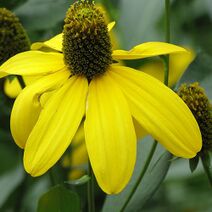Rudbeckia laciniata
| Rudbeckia laciniata | |
 | |
| Light: | |
| Moisture: | |
| Hardiness: | 3 |
| Soil pH: | 5.6-8.4 |
| Height: | 8' |
| Width: | 3' |
| Blooms: | Mid Summer-Mid Fall |
| Native to: | |
| Nectary | |
| Edible Rating: | |
| Medicinal Rating: | |
| Tea: | Yes |
Rudbeckia laciniata (common names: cone flower and wild golden glow)
Propagation: Seed - sow April in a greenhouse. Only just cover the seed. Germination should take place within 2 weeks, prick out the seedlings into individual pots when they are large enough to handle and plant them out in the summer[K]. The seed can also be sown in situ[1].
Division in spring or autumn[1]. Very easy, larger divisions can be planted out direct into their permanent positions. We have found it best to pot up the smaller divisions and grow them on in a lightly shaded position in a cold frame, planting them out once they are well established in the summer.
Cultivation: Succeeds in an ordinary medium soil in sun or shade[1]. Requires a moist soil[2]. Prefers a well-drained soil[3]. Tolerates considerable wind exposure without support[K]. Plants can be grown in quite coarse grass, which can be cut annually in the autumn[4]. They grow particularly well in long hot late summers[5].
Dormant plants are hardy to about -25°c[6].
Some named forms have been selected for their ornamental value[6].
Members of this genus are rarely if ever troubled by browsing deer[4].
Plants can be invasive[5].
Range: N. America - Quebec to Manitoba, Colorado Florida. Locally naturalized garden escape in Britain[7].
Habitat: Stream banks and moist places in rich low ground[8][9].
Edibility: Edible young stems[10][11][12]. Cooked and eaten in the spring for 'good health'[13][14]. The young stems can be eaten like celery[14]. The stems can also be dried for later use[14]. Some caution is advised, see the notes above on toxicity.
Medicinal: A tea made from the root (mixed with Caulophyllum thalictroides) is used in the treatment of indigestion[13][14].
A poultice of the flowers (mixed with Agastache anisatum and Solidago sp.) is applied to burns[13][14].
Usage: A green dye is obtained from the flowers[15].
Pollinators: Bees, hoverflies
Soil: Can grow in light, medium, and heavy soils.
Wind: Tolerates strong winds
Seed Ripens: Late Summer-Mid Fall
Flower Type: Hermaphrodite
Known Hazards: This plant is reputed to be poisonous to cattle, sheep and pigs[11].
Links
References
- ↑ 1.0 1.1 1.2 Sanders, Thomas. Popular Hardy Perennials. Collingridge, 1926.
- ↑ Chittendon, Fred. RHS Dictionary of Plants. Oxford University Press, 1951.
- ↑ Brickell, Christopher. The RHS Gardener's Encyclopedia of Plants and Flowers. Dorling Kindersley Publishers, 1990.
- ↑ 4.0 4.1 Thomas, Graham. Perennial Garden Plants. J. M. Dent & Sons, 1990.
- ↑ 5.0 5.1 Huxley, Anthony. The New Royal Horticultural Society Dictionary of Gardening. MacMillan Press, 1992.
- ↑ 6.0 6.1 Phillips, Roger and Martyn Rix. Perennials - The Definitve Reference. Pan Books, 1991.
- ↑ Clapham, Arthur and Tom Tootin, Edmund Warburg. Flora of the British Isles. Cambridge University Press, 1962.
- ↑ Lyndon, Merritt. Gray's Manual of Botany. American Book Co, 1950.
- ↑ Hitchcock, Leo. Vascular Plants of the Pacific Northwest. University of Washington Press, 1955.
- ↑ Tanaka, Tyōzaburō. Tanaka's Cyclopaedia of Edible Plants of the World. Keigaku Publishing, 1976.
- ↑ 11.0 11.1 Arnberger, Leslie. Flowers of the Southwest Mountains. Southwestern Monuments, 1968.
- ↑ Yanovsky, Elias. Food Plants of the North American Indians Publication 237. US Department of Agriculture.
- ↑ 13.0 13.1 13.2 Foster, Steven and Billy Tatum. Medicinal Plants of Eastern and Central North America. Houghton Mifflin, 1990.
- ↑ 14.0 14.1 14.2 14.3 14.4 Moerman, Daniel. Native American Ethnobotany. Timber Press, 1998.
- ↑ Grae, Ida. Nature's Colors. MacMillan Publishing, 1974.